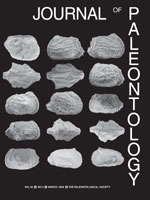The Kel'tminskaya-1 borehole, drilled along the northeastern margin of the East European Platform (EEP), reveals some 3,600 m of Neoproterozoic sedimentary rocks, mostly confined to the subsurface. The upper 1,000 m of the drilled section correlates with late Ediacaran Redkino and Kotlin successions on the EEP, whereas the lowermost 2,000 m can be related to pre-Sturtian (Upper Riphean) deposits in the Ural Mountains. In between lies the Vychegda Formation, a 600 m siliciclastic succession that has no counterpart in classic EEP stratigraphy.
Vychegda microfossils can be separated into three assemblages. The upper part of the formation contains large, profusely ornamented acritarchs broadly comparable to those of the Ediacaran Complex Acanthomorph Palynoflora, including species of the genera Alicesphaeridium, Asterocapsoides, Cavaspina and Tanarium confined to Ediacaran-aged assemblages elsewhere. Diverse large acanthomorphs are known from Ediacaran strata around the world, but have not previously been recognized from the EEP, an absence attributed to a hiatus between the glacial Laplandian (>635 Ma) and Redkino (mostly <555 Ma) successions. The large acanthomorphic acritarchs record eukaryotic organisms with resting stages in their life cycles and likely include egg or diapause cysts of early animals. In contrast, the lower Vychegda assemblage, found in the basal 10 m of the succession, contains taxa typical of earlier Neoproterozoic successions. The middle assemblage contains only simple filaments and spheroidal acritarchs.
The most parsimonious interpretation of Vychegda biostratigraphy is that pre-Marinoan rocks in the basal part of the formation are separated by a cryptic unconformity from early and middle Ediacaran deposits above. This interpretation is consistent with data from China and Australia, which indicate that the major paleontological transition to diverse ECAP assemblages took place within the Ediacaran Period and not in association with the preceding ice age. Vychegda acritarch assemblages thus contribute to a biostratigraphic model for the initial Ediacaran boundary.





